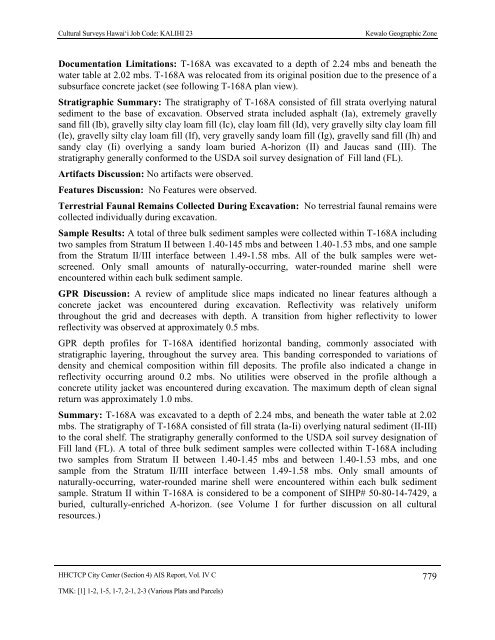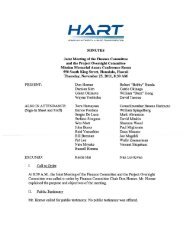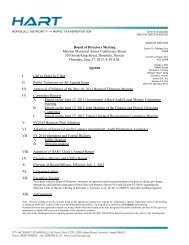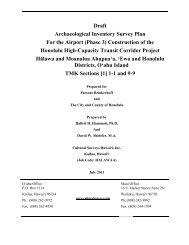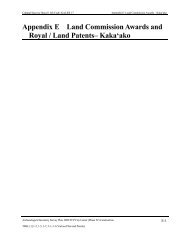4.12 Test Excavation 167 (T-167) - Honolulu Rail Transit Project
4.12 Test Excavation 167 (T-167) - Honolulu Rail Transit Project
4.12 Test Excavation 167 (T-167) - Honolulu Rail Transit Project
You also want an ePaper? Increase the reach of your titles
YUMPU automatically turns print PDFs into web optimized ePapers that Google loves.
Cultural Surveys Hawai‘i Job Code: KALIHI 23Kewalo Geographic ZoneDocumentation Limitations: T-168A was excavated to a depth of 2.24 mbs and beneath thewater table at 2.02 mbs. T-168A was relocated from its original position due to the presence of asubsurface concrete jacket (see following T-168A plan view).Stratigraphic Summary: The stratigraphy of T-168A consisted of fill strata overlying naturalsediment to the base of excavation. Observed strata included asphalt (Ia), extremely gravellysand fill (Ib), gravelly silty clay loam fill (Ic), clay loam fill (Id), very gravelly silty clay loam fill(Ie), gravelly silty clay loam fill (If), very gravelly sandy loam fill (Ig), gravelly sand fill (Ih) andsandy clay (Ii) overlying a sandy loam buried A-horizon (II) and Jaucas sand (III). Thestratigraphy generally conformed to the USDA soil survey designation of Fill land (FL).Artifacts Discussion: No artifacts were observed.Features Discussion: No Features were observed.Terrestrial Faunal Remains Collected During <strong>Excavation</strong>: No terrestrial faunal remains werecollected individually during excavation.Sample Results: A total of three bulk sediment samples were collected within T-168A includingtwo samples from Stratum II between 1.40-145 mbs and between 1.40-1.53 mbs, and one samplefrom the Stratum II/III interface between 1.49-1.58 mbs. All of the bulk samples were wetscreened.Only small amounts of naturally-occurring, water-rounded marine shell wereencountered within each bulk sediment sample.GPR Discussion: A review of amplitude slice maps indicated no linear features although aconcrete jacket was encountered during excavation. Reflectivity was relatively uniformthroughout the grid and decreases with depth. A transition from higher reflectivity to lowerreflectivity was observed at approximately 0.5 mbs.GPR depth profiles for T-168A identified horizontal banding, commonly associated withstratigraphic layering, throughout the survey area. This banding corresponded to variations ofdensity and chemical composition within fill deposits. The profile also indicated a change inreflectivity occurring around 0.2 mbs. No utilities were observed in the profile although aconcrete utility jacket was encountered during excavation. The maximum depth of clean signalreturn was approximately 1.0 mbs.Summary: T-168A was excavated to a depth of 2.24 mbs, and beneath the water table at 2.02mbs. The stratigraphy of T-168A consisted of fill strata (Ia-Ii) overlying natural sediment (II-III)to the coral shelf. The stratigraphy generally conformed to the USDA soil survey designation ofFill land (FL). A total of three bulk sediment samples were collected within T-168A includingtwo samples from Stratum II between 1.40-1.45 mbs and between 1.40-1.53 mbs, and onesample from the Stratum II/III interface between 1.49-1.58 mbs. Only small amounts ofnaturally-occurring, water-rounded marine shell were encountered within each bulk sedimentsample. Stratum II within T-168A is considered to be a component of SIHP# 50-80-14-7429, aburied, culturally-enriched A-horizon. (see Volume I for further discussion on all culturalresources.)HHCTCP City Center (Section 4) AIS Report, Vol. IV C 779TMK: [1] 1-2, 1-5, 1-7, 2-1, 2-3 (Various Plats and Parcels)


